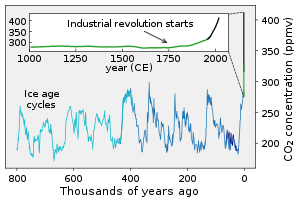
Back إيميان Arabic Муравінскае міжледавікоўе BE Interglacial Riss-Würm Catalan Eemský interglaciál Czech Eem-mellemistiden Danish Eem-Warmzeit German Interglaciar Riss-Würm Spanish Eem-interglasiaali Finnish Éémien French Eemiano GL


The Last Interglacial, also known as the Eemian, was the interglacial period which began about 130,000 years ago at the end of the Penultimate Glacial Period and ended about 115,000 years ago at the beginning of the Last Glacial Period.[1] It corresponds to Marine Isotope Stage 5e.[2] It was the second-to-latest interglacial period of the current Ice Age, the most recent being the Holocene which extends to the present day (having followed the last glacial period). During the Last Interglacial, the proportion of CO2 in the atmosphere was about 280 parts per million.[3] The Last Interglacial was one of the warmest periods of the last 800,000 years, with temperatures comparable to and at times warmer (by up to on average 2 degrees Celsius) than the contemporary Holocene interglacial,[4][5] with the maximum sea level being up to 6 to 9 metres higher than at present, with global ice volume likely also being smaller than the Holocene interglacial.[6]
The Last Interglacial is known as the Eemian in northern Europe (sometimes used to describe the global interglacial), Ipswichian in Britain, the Mikulino (also spelled Milukin) interglacial in Russia, the Kaydaky in Ukraine, the Valdivia interglacial in Chile, and the Riss-Würm interglacial in the Alps. Depending on how a specific publication defines the Sangamonian Stage of North America, the Last Interglacial is equivalent to either all or part of it.
The period falls into the Middle Paleolithic and is of some interest for the evolution of anatomically modern humans, who were present in Western Asia (Skhul and Qafzeh hominins) as well as in Southern Africa by this time, representing the earliest split of modern human populations that persists to the present time (associated with mitochondrial haplogroup L0).[7] As the most recent point in time with a climate comparable to the Holocene, the Last Interglacial is also of relevance as a point of reference (baseline) for nature conservation.
- ^ Dahl-Jensen, D.; Albert, M. R.; Aldahan, A.; Azuma, N.; Balslev-Clausen, D.; Baumgartner, M.; et al. (2013). "Eemian interglacial reconstructed from a Greenland folded ice core" (PDF). Nature. 493 (7433): 489–494. Bibcode:2013Natur.493..489N. doi:10.1038/nature11789. PMID 23344358. S2CID 4420908.
- ^ Shackleton, Nicholas J.; Sánchez-Goñi, Maria Fernanda; Pailler, Delphine; Lancelot, Yves (2003). "Marine Isotope Substage 5e and the Eemian Interglacial" (PDF). Global and Planetary Change. 36 (3): 151–155. Bibcode:2003GPC....36..151S. CiteSeerX 10.1.1.470.1677. doi:10.1016/S0921-8181(02)00181-9. Archived from the original (PDF) on 2016-03-03. Retrieved 2014-08-07.
- ^ Kaufman, Mark (27 August 2018). "Earth is the warmest it's been in 120,000 years". Mashable.
- ^ Shackleton, S.; Baggenstos, D.; Menking, J. A.; Dyonisius, M. N.; Bereiter, B.; Bauska, T. K.; Rhodes, R. H.; Brook, E. J.; Petrenko, V. V.; McConnell, J. R.; Kellerhals, T.; Häberli, M.; Schmitt, J.; Fischer, H.; Severinghaus, J. P. (2020-01-02). "Global ocean heat content in the Last Interglacial". Nature Geoscience. 13 (1): 77–81. Bibcode:2020NatGe..13...77S. doi:10.1038/s41561-019-0498-0. ISSN 1752-0894. S2CID 209897368.
- ^ Thomas, Zoë A.; Jones, Richard T.; Turney, Chris S. M.; Golledge, Nicholas; Fogwill, Christopher; Bradshaw, Corey J. A.; Menviel, Laurie; McKay, Nicholas P.; Bird, Michael; Palmer, Jonathan; Kershaw, Peter; Wilmshurst, Janet; Muscheler, Raimund (April 2020). "Tipping elements and amplified polar warming during the Last Interglacial". Quaternary Science Reviews. 233: 106222. Bibcode:2020QSRv..23306222T. doi:10.1016/j.quascirev.2020.106222. S2CID 216288524.
- ^ Barlow, Natasha L. M.; McClymont, Erin L.; Whitehouse, Pippa L.; Stokes, Chris R.; Jamieson, Stewart S. R.; Woodroffe, Sarah A.; Bentley, Michael J.; Callard, S. Louise; Ó Cofaigh, Colm; Evans, David J. A.; Horrocks, Jennifer R.; Lloyd, Jerry M.; Long, Antony J.; Margold, Martin; Roberts, David H. (September 2018). "Lack of evidence for a substantial sea-level fluctuation within the Last Interglacial". Nature Geoscience. 11 (9): 627–634. Bibcode:2018NatGe..11..627B. doi:10.1038/s41561-018-0195-4. ISSN 1752-0894. S2CID 135048938.
- ^ M Richards et al. in: Bandelt et al. (eds.), Human Mitochondrial DNA and the Evolution of Homo sapiens, Springer (2006), p. 233.